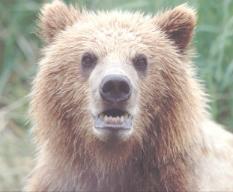 Photo: This could well be the most recent grizzly bear sighting in the North Cascades. Proving it is another matter. Photo by Pat Lathrop.
Photo: This could well be the most recent grizzly bear sighting in the North Cascades. Proving it is another matter. Photo by Pat Lathrop.Look at the picture above very carefully. You're looking at a family of bears crossing a glacier in the North Cascades mountains in the summer of 2006. But are they black bears or grizzly bears? That's the million dollar question. The picture was submitted to me by Pat Lathrop who, while hiking the Glacier Peak Wilderness came across this amazing site with a friend. As he raised the binoculars to his eyes he knew the significance of what he was witnessing. Without saying a word, he quietly handed his binoculars to his hiking companion and asked, "What do you think they are?". His friend replied, "Wow - it's a family of grizzly bears!". This is how Pat relayed the story to me as we spoke on the phone. He explained that he had been to one of my slide shows several years earlier at REI and that he therefore understood how important a sighting like this was. Pat has seen many bears - both grizzly and black, in other parts of North America, and he was personally "one hundred percent sure" that what he saw that day was a family of grizzly bears crossing the glacier from one valley to the next. When he handed the binoculars to his friend he didn't want to influence his response, so he kept quiet. His friend's reaction only further convinced Pat that this was a very special moment.
The problem is follow-up. How do we prove that these were in fact grizzly bears? Of course the dots on the photograph can't be used for verification, but what about trying to track them in the field? Looking for tracks is one option, but they are extremely tough to find. We can use remotely-triggered cameras, or even hair snags that capture a clump of DNA from the cpat of a passing bear. Even a pile of scat can yield DNA which would tell us if it was left behind by a black or grizzly bear. But when you consider that a female bear and yearlings might cover 200-300 square miles as part of their regular home range, the problems of sighting verification become obvious.
When there are fewer than 20 grizzly bears left in the 10,000 square mile North Cascades ecosystem it is critical that any possible sighting is reported. We receive about 20 reports per year thanks to the very active GBOP field crew who are out there interacting with the public all year round, and thanks also to an online reporting system we've developed. However, my guess is that, on average, about 17 of these 20 sound like black bears that people have confused with grizzly bears (an easy thing to do when you consider that black and grizzly bears can have coats that are anything from blonde to black).
Please spread the word - if you see a North Cascades grizzly bear, let us know! (GBOP sighting report). For MUCH more information about bears in the cascades, go to our website: www.bearinfo.org
Chris Morgan, Bear ecologist, GBOP Director
